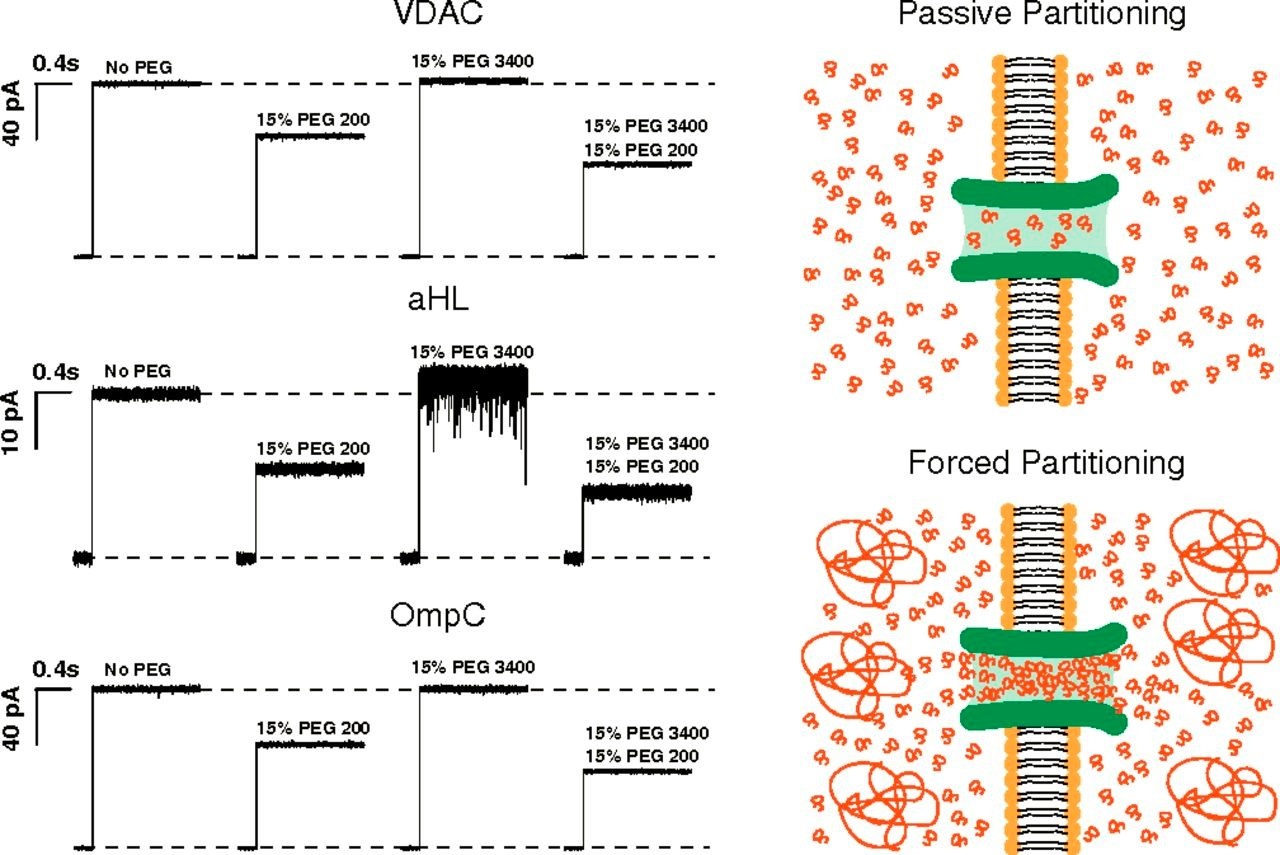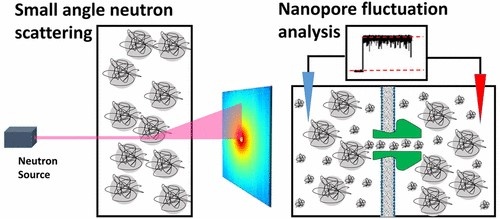Polymers and Small Osmolytes to Probe Ion Channels
Molecular crowding by water-soluble polymers, such as poly(ethylene glycol)s, PEGs, has been employed in a wide range of inquiries into molecular structure and dynamics. Specifically, polymer partitioning into nanoscale cavities can sensitively probe surface hydration in application to molecular interactions in the crowded cellular environment. Metabolite-transporting beta-barrel ion channels reconstituted into planar lipid bilayers offer a useful model system for studying both polymer partitioning from multicomponent solutions and its osmotic action. Also, with conductance-fluctuation analysis we can access the dynamic side of polymer partitioning, allowing us to follow polymer transport at the single-molecule level which offers advantages over ensemble techniques. We apply osmolytes and polymers to study polymer behavior under conditions of strong confinement by the pores and to investigate water molecules rearrangements in complexation reactions.

Figure 1. Polymer partitioning from semidilute solutions of PEG mixtures studied with a number of membrane-spanning β-barrel channels of different origin: the voltage-dependent anion channel (VDAC) from outer mitochondrial membrane, bacterial porin OmpC, and channel-forming toxin alpha-hemolysin. PEGs of molecular weight 200 (PEG 200) and 3400 (PEG 3400), and their mixtures in different proportions, were used. The results for the mixtures were rationalized within the “polymers-pushing-polymers” model of nanopore partitioning, based on the assumptions that the larger component of the polymer mixture, being preferentially excluded from the channel cavity, pushes the smaller component into it, thus representing forced polymer redistribution between the bulk and the channel volumes (from M. A., Aksoyoglu, R. Podgornik, S. M. Bezrukov, P. A. Gurnev, M. Muthukumar, and V. A. Parsegian. Size-dependent forced PEG partitioning into channels: VDAC, OmpC, and α-hemolysin.Proceedings of the National Academy of Sciences, 2016, 113: 9003–9008).

Figure 2.Using two different methods—small-angle neutron scattering (SANS) and nanopore conductance fluctuation analysis to quantify PEG parameters in the bulk and the degree of its partitioning into the pore of alpha-hemolysin channel. While SANS indicated very small decrease in polymer radius of gyration in 1-30% wt % solutions of PEG3400, current-fluctuation analysis on mixed large and small polymer samples showed that an osmotic “push” exerted by the larger PEG3400 is enough to selectively drive the smaller one, PEG 200, into the channel pore. For the 1:1 mixture of PEGs of 200 and 3400 molecular weight, and of total 30% w/w PEG concentration, the dominance of smaller PEG 200 in pore partitioning is such, that only 0.04 of pore volume is taken by the large PEG 3400. This selective drive of the small polymers can represent a new type of regulation of molecular transport, which may be of great importance in vivo, where a dense amount of biopolymers is packed into small cellular volumes (from P. A. Gurnev, C. B. Stanley, M. A. Aksoyoglu, K. Hong, V. A. Parsegian, and S. M Bezrukov. Poly(ethylene glycol)s in semidilute regime: radius of gyration in the bulk and partitioning into a nanopore.Macromolecules, 2017, 50:2477–2483).
Publications:
Hoogerheide DP, Gurnev PA, Rostovtseva TK, and Bezrukov SM (2022) Voltage-activated complexation of alpha-synuclein with three diverse beta-barrel channels: VDAC, MspA, and alpha-hemolysin. Proteomics. 225-6:e2100060. https://doi.org/10.1002/pmic.202100060 
P.A. Gurnev, C. B. Stanley, M. A. Aksoyoglu, K. Hong, V. A. Parsegian, and S. M Bezrukov. Poly(ethylene glycol)s in semidilute regime: radius of gyration in the bulk and partitioning into a nanopore. Macromolecules, 2017, 50:2477–2483.
M.A. Aksoyoglu, R. Podgornik, S.M. Bezrukov, P.A. Gurnev, M. Muthukumar, and V.A. Parsegian. Size-dependent forced PEG partitioning into channels: VDAC, OmpC, and α-hemolysin. Proceedings of the National Academy of Sciences, 2016, 113:9003–9008.
P.A. Gurnev, R. Ortenberg, T. Dörr, K. Lewis, and S.M. Bezrukov. Persister-promoting bacterial toxin TisB produces anion-selective pores in planar lipid bilayers. FEBS Letters, 2012, 586:2529–2534.
P.A. Gurnev, T.K. Rostovtseva, and S.M. Bezrukov. Tubulin-blocked state of VDAC studied by polymer and ATP partitioning. FEBS Letters, 2011, 585:2363–2366.
P.A. Gurnev, D. Harries, V.A. Parsegian, and S.M. Bezrukov. Osmotic stress regulates the strength and kinetics of sugar binding to maltoporin channel. Journal of Physics: Condensed Matter, 2010, 22:454110.
E.M. Nestorovich, V.A. Karginov, and S.M. Bezrukov. Polymer partitioning and ion selectivity suggest asymmetrical shape for the membrane pore formed by Epsilon toxin. Biophysical Journal, 2010, 99:782–789.
P.A. Gurnev, D. Harries, V.A. Parsegian, and S.M. Bezrukov. The dynamic side of the Hofmeister effect: A single-molecule nanopore study of specific complex formation. ChemPhysChem, 2009, 10:1445–1449.
O.S. Ostroumova, P.A. Gurnev, L.V. Schagina, and S.M. Bezrukov. Asymmetry of syringomycin E channel studied by polymer partitioning. FEBS Letters, 2007, 581:804–808.
O.V. Krasilnikov, C.G. Rodrigues, and S.M. Bezrukov. Single polymer molecules in a protein nanopore in the limit of a strong polymer-pore attraction. 
E.M. Nestorovich, E. Sugawara, H. Nikaido, and S.M. Bezrukov. Pseudomonas aeruginosa porin OprF: Properties of the channel. Journal of Biological Chemistry, 2006, 281:16230–16237.
V.Yu. Zitserman, A.M. Berezhkovskii, V.A. Parsegian, and S.M. Bezrukov. Non-ideality of polymer solutions in the pore and concentration-dependent partitioning. Journal of Chemical Physics, 2005, 123:146101.
V.Yu. Zitserman, K.S. Stojilkovic, A.M. Berezhkovskii, and S.M. Bezrukov. Electrical conductivity of aqueous solutions of polyethylene glycol. 
S.M. Bezrukov, O.V. Krasilnikov, L.N. Yuldasheva, A.M. Berezhkovskii, and C.G. Rodrigues. Field-dependent effect of crown ether (18-crown-6) on ionic conductance of alpha-hemolysin channels. Biophysical Journal, 2004, 87:3162–3171.
O.V. Krasilnikov and S.M. Bezrukov. Polymer partitioning from non-ideal solutions into protein voids. 
K.S. Stojilkovic, A.M. Berezhkovskii, V.Yu. Zitserman, and S.M. Bezrukov. Conductivity and microviscosity of electrolyte solutions containing polyethylene glycols. 
T.K. Rostovtseva, E.M. Nestorovich, and S.M. Bezrukov. Partitioning of differently sized poly(ethylene glycol)s into OmpF porin. Biophysical Journal, 2002, 82(1 Pt 1):160–169.
S.M. Bezrukov and J.J. Kasianowicz. Neutral polymers in the nanopores of alamethicin and alpha-hemolysin. 
S.M. Bezrukov. Ion channels as molecular Coulter counters to probe metabolite transport. Journal of Membrane Biology, 2000, 174:1–13.
P.G. Merzlyak, L.N. Yuldasheva, C.G. Rodrigues, C.M.M. Carneiro, O.V. Krasilnikov, and S.M. Bezrukov. Polymeric nonelectrolytes to probe pore geometry: Application to the alpha-toxin transmembrane channel. Biophysical Journal, 1999, 77:3023–3033.
A.M. Berezhkovskii, S.M. Bezrukov, D.J. Bicout, and G.H. Weiss. The influence of polymer on the diffusion of a spherical tracer. 
Yu.A. Kaulin, L.V. Schagina, S.M. Bezrukov, V.V. Malev, A.M. Feigin, J.Y. Takemoto, J.H. Teeter, J.G. Brand. Cluster organization of ion channels formed by the antibiotic syringomycin E in bilayer lipid membranes. 
S.M. Bezrukov and J.J. Kasianowicz. The charge state of an ion channel controls neutral polymer entry into its pore. European Biophysics Journal, 1997, 26:471–476.
S.M. Bezrukov, I. Vodyanoy, R.A. Brutyan, and J.J. Kasianowicz. Dynamics and free energy of polymers partitioning into a nanoscale pore. 
V.A. Parsegian, S.M. Bezrukov, and I. Vodyanoy. Watching small molecules move: interrogating ionic channels using small solutes. 
S.M. Bezrukov, I. Vodyanoy, and V.A. Parsegian. Counting polymers moving through a single ion channel. Nature (London), 1994, 370:279–281.
I. Vodyanoy, S.M. Bezrukov, and V.A. Parsegian. Probing alamethicin channels with water-soluble polymers. Size-modulated osmotic action. Biophysical Journal, 1993, 65:2097–2105.
S.M. Bezrukov and I. Vodyanoy. Probing alamethicin channels with water-soluble polymers. Effect on conductance of channel states.Biophysical Journal, 1993, 64:16–25.
I. Vodyanoy and S.M. Bezrukov. Sizing of an ion pore by access resistance measurements. Biophysical Journal, 1992, 62:10–11.
 BACK TO TOP
BACK TO TOP